If I Only Had a Brine: Pickle Sandwiches
What is a Pickle Sandwich?
If you are the kind of person who sees a lot of sandwich-related content come across their social media feeds, as I am, you’ve probably seen many a pickle sandwich meme over the past couple of years. There’s the sub sandwich shop in New Jersey who went viral when they started serving all their sandwiches in pickles; the Japanese news writer who added $80 worth of extra pickles to a Burger King whopper; hamburger grammar; the McPigkle. Invariably at least half the comments will be from people claiming that they’d devour this concoction. I tried making a Big Mac with “two all beef patties pickles pickles pickles pickles pickles pickles on a sesame seed bun” and I couldn’t bring myself to eat the vulgar thing.



And that’s fine, ’cause this dumb stunt is not really what our pickle sandwich story is about. Neither are the sandwiches-inna-pickle, though my experimentation with those was at least somewhat successful. I bought some half-sour pickles to go from a restaurant in Chicago’s Printer Row neighborhood…
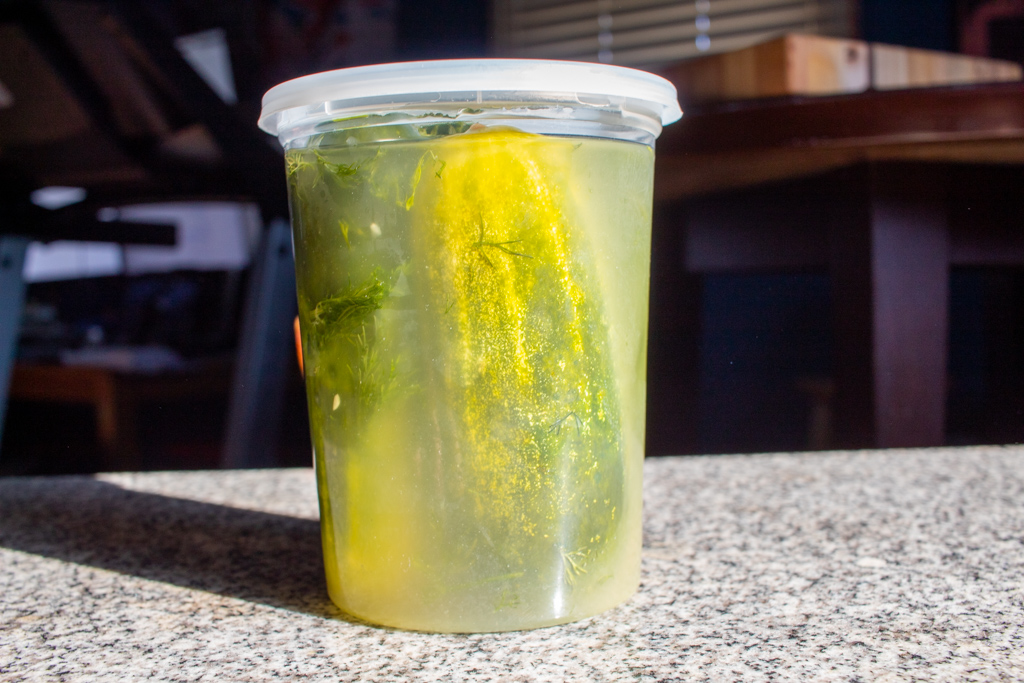
The restaurant is very helpfully named “Half Sour,” making it a convenient find when seeking out this style of pickle. The large thick-skinned cucumbers themselves were only mildly fermented and far less salty than a typical Kosher dill, allaying somewhat the fears I’d had that a pickle sub would be a sodium bomb.
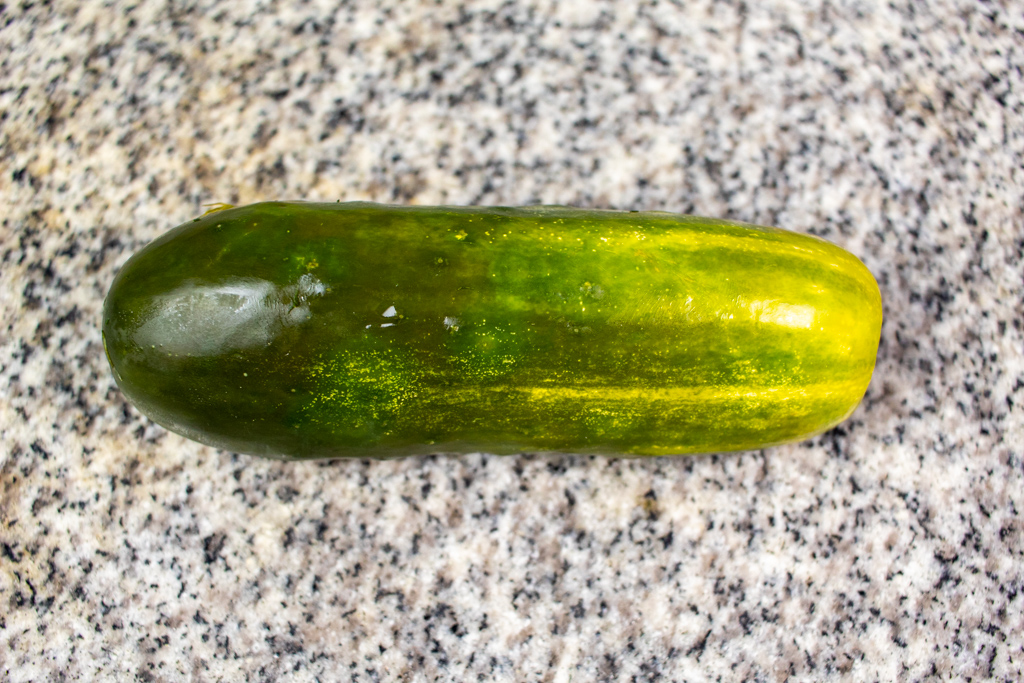
I chose to go with a fairly standard “Deli Special” type sandwich for my pickle sub attempt, so after cutting the pickle in half and scooping out the seeds I added Swiss cheese, smoked turkey, corned beef, coleslaw, onions, tomatoes, and Thousand Island dressing.





I also cut a thin sliver off the bottom half of the pickle to make it sit nicely for the photos. Using frilly cocktail toothpicks seems to be the more common practice though.



I had to try this one multiple times though–pickles are wet, and tomatoes are wet, and coleslaw is wet, and the sandwich turns into a gloppy unmanageable mess if you don’t drain the wet ingredients sufficiently before putting it all together.

This post isn’t even really about the multiple random pickle sandwiches I tried this month, such as the suggestion my friend Alexandra made–homemade garlicky Polish-style pickles with sharp cheddar on toasted sourdough with butter and salt. I used a 5-year Wisconsin cheddar and my friends Dave and Cori’s excellent garlic dills made from their own home-grown cucumbers.
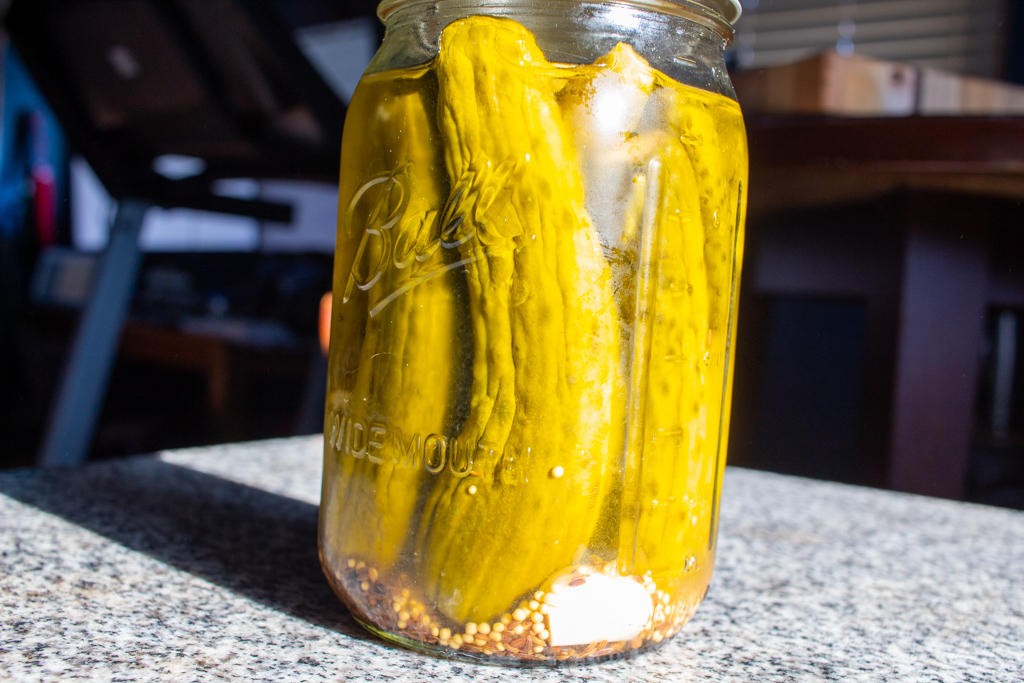
They were still crisp and delightfully pungent after several months in the jar, and between the warm and rigid toasted sourdough, the melting butter, the crisp briny pickles and the assertive cheese there was a lot to like in this sandwich. It was a good one, AK, thanks!




Nor are we here to discuss this similar sandwich recipe I found on Food52, which also uses sharp cheddar but with half-sour pickles (again, I used the good but very mild version from Half-Sour in Chicago). The sandwich specifies a seeded bread and I chose the dense, moist Whole Grain Dark Wheat from Pepperidge Farms. The unique part here is the pickle dijonnaise made from minced half-sours, mayonnaise, dijon mustard, and brine from the pickle jar. It takes what otherwise might be a mostly forgettable combination of good quality ingredients and gives it a memorable funk, the volatile sulfurous allyls of the mustard taking that strange aroma and flavor of pleasing rot that characterizes fermented foods like the pickle and fast-tracking it right to your sinuses.
They’re good sandwiches, for the most part, and I’m glad to have tried them. But mostly this post was inspired by an article about bread and butter pickles.
Origins
The story of the pickle sandwich and, in turn, the story of the sweet-and-sour cucumbers we call “bread and butter pickles” alternates, it seems, between speculation and certainty. The speculation comes mostly on the part of the bloggers (and even sometimes the paid-by-the-word food writers) who, like myself, need to crank out an article about them to meet a deadline (even a self-imposed one) and move on. The certainty, on the other hand, seems to be the sole domain of the internet commentariat who tells them they are wrong.
There’s the Saveur article from 2020 (also republished in Popular Science) that uses very guarded language to suggest that maybe–maybe–pickle sandwiches, or bread and butter pickle sandwiches, or maybe even peanut butter and pickle sandwiches, originated during the Great Depression.
A correction appended to the end of the article, however, gives another more detailed origin to the term.
Update: One of the first recorded uses of the phrase “bread and butter pickles” can be traced back to 1923, when Omar and Cora Fanning of Illinois registered for a trademark (since expired) on the logo for their family pickles. According to a 1996 issue of the Feingold News, “Mrs. Fanning worked out an agreement with a local grocer, who gave her groceries—including bread ‘n butter—in exchange for the pickles.”
This information was provided to the author by a reader of the site, who was graciously thanked in said correction. And it is true: if you do a trademark lookup against bread and butter pickles you’ll find that a name and even a logo were registered for Fanning’s Bread and Butter Pickles in 1923:
Other writers have received less genteel corrections. In a bread and butter pickles post on her recipe site “Cottage at the Crossroads,” blogger Jane speculated that “they got their name because during the Great Depression, they were a cheap staple in households. So people used them in sandwiches of bread and butter because that’s all they could afford.”
In the comments section, a tempest in a picklepot began to rage.
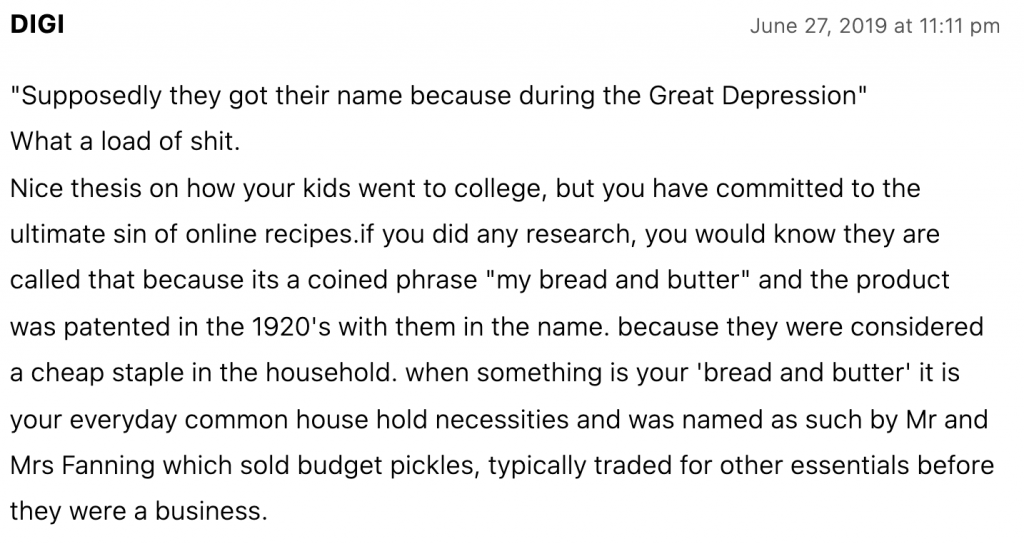
Let me just run that through my Internet-to-decent-human-being translator: “I disagree with your assertion vis-a-vis the Great Depression and I think you may have committed an error in researching this recipe that you published seven and a half years before I made this comment. I have recently read that some farmers in Illinois made bread and butter pickles in the 1920s and though I am unclear on the details this renders your entire thesis invalid.”
Well, our blogger Jane replied to this comment in a manner that I’m sure she thought was breezy but may be interpreted as somewhat snooty or even dismissive.

Yet another commenter rushed to DIGI’s aid 17 months later with this blistering retort:
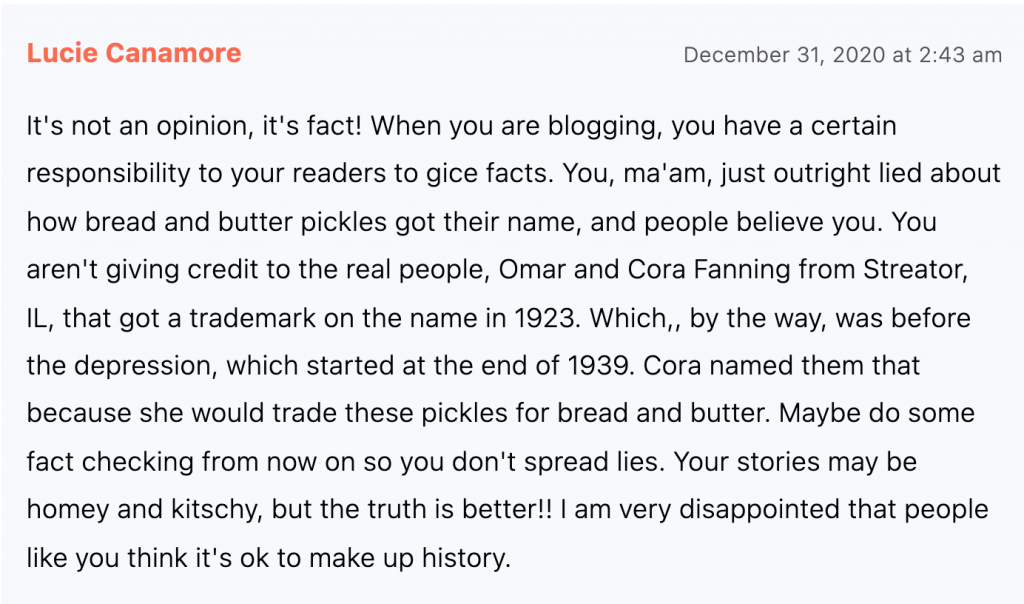
Sadly, this one has broken my translator. The reader seems to be angry that Jane has lied and made up history about the origin of bread and butter pickles. I could mention that this commenter has invented words like “gice,” which appears to mean something like “get it right” or “don’t guess” or perhaps has some darker meaning beyond my ken. I could also mention that this commenter has made up history by asserting that the Great Depression began in late 1939, but I’ll give her the benefit of the doubt and assume she meant 1929.
I think what I want to concentrate on here though is the absurd idea that a blogger has some kind of sacred responsibility to always be right. We don’t. I get things wrong all the time. When someone corrects me, I thank them and try to do better going forward. I certainly want to get things right, and I’m sure Jane does too. But these are not peer-reviewed theses being published in academic journals that you’re reviling here. A blogger is usually simply someone with a deep interest in a specific subject who wants to share that interest with others (or maybe just wants to pepper their site with ads and affiliate links and let the big blog bucks flow). If you don’t like what they’re saying about it there are probably a dozen other blogs that agree with whatever you already think that you may feel more comfortable reading. If you don’t like how they’re saying it, you can always just not read it.
And speaking of peer-review, where are the commenter’s sources for the assertion that the Fannings invented bread and butter pickles? Was the idea divinely beamed into Cora Fanning’s brain to be propagated through the world? Or did the Fannings trademark, not the idea of “bread and butter pickles” itself, but the Fannings brand of bread and butter pickles? Did the style of pickle exist before the Fannings interest in it? Could I find other accounts of or recipes for bread and butter pickles contemporary to the Fannings 1923 trademark application or even predating it? And would I be willing to put in the hours of research to do it, simply to spite an angry internet commenter who would (hopefully) never even see this post?
As it happens, I found one in about 5 minutes.
An Historical Digression
It turns out that it isn’t easy to use search engines to look for bread and butter pickle recipes in old cookbooks and magazines. This is due to a combination of factors. First is the nature of American cookbooks and magazines of 100+ years ago. They were for the most part written not as a source of aspirational dishes to inspire the budding chef, but rather as housekeeping guides for the wives and mothers of the day. So in addition to recipes, they contained many meal plans, lists of what dishes could go on the table together and how slices of that leftover roast could be reused for luncheon the next day. Another factor is the nature of search engines, in that they largely ignore punctuation. Thus, “Bread and butter. Pickles.” registers to the search engine the same as “Bread and butter pickles,” resulting in page after page of results like this from the Chicago Record Cook Book of 1896:
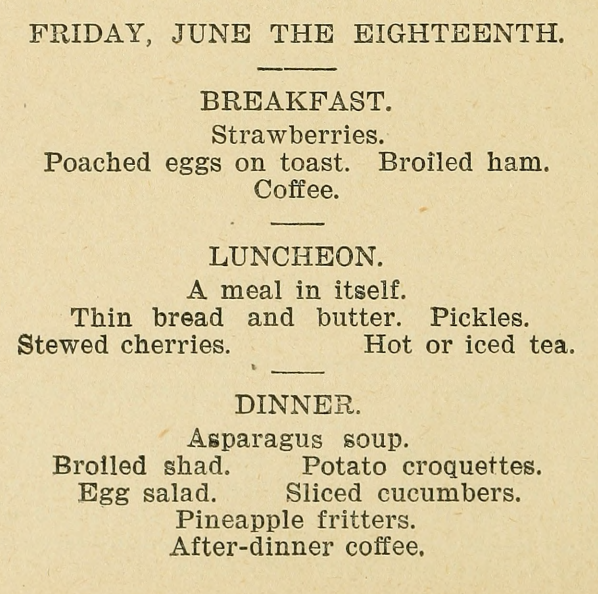
And still, I was almost immediately able to find a recipe from a cookbook dated 1920 for Bread and Butter Pickles.

Not a major publication, this cookbook simply titled Cook Book was compiled by the Ladies Aid Society of the Danish Lutheran Church of Rosenborg, Nebraska, according to the front cover. It was printed by the Reporter Press in nearby Newman Grove, Nebraska according to the back cover. And nowhere in the 80 or so pages between those two covers is a date of publication printed. Multiple notes handwritten in pencil on the pages themselves estimate the date to be 1920 but that appears to be largely a guess.
So I did a little research. Something sensible, like making a phone call to whatever remnant of the Newman Grove Reporter might still exist today and asking if they have a record of the publication date of this cookbook? No, that would make too much sense. Instead, I found that Mrs. Alfred Andreason was likely Mae Hattie Andreason, nee Smolinsky, born in Nebraska in January of 1903. Alfred Andreason–or perhaps to be fair we should call him Mr. Mae Smolinksy–was born in Genoa, 12 miles south of Rosenborg, in January 1901, and that is where they are both buried as well.
The dates of birth make Mae and Alfred 17 and 19 respectively in 1920 when this cookbook was reportedly published, and at a time when the average age at marriage in the US was 21.2 for women and 24.6 for men. They were young–but they were country folk in small town Nebraska, statistically more likely to marry young than the urbanites skewing that average so high. However, while I could not find an actual marriage date, the years their children were born–1925, 1926, and 1930–make it unlikely that she was “Mrs. Alfred Andreason” too much earlier than 1924.
So perhaps this recipe does not predate the Fannings’ trademark application after all but it is contemporaneous with it, from an unrelated community hundreds of miles to the west. The sweet pickled cucumber and onion of the recipe above is in fact a very Danish recipe, similar to Agurksalat, and it is not surprising at all to see it come from an area in Nebraska that was heavily settled by Danish immigrants in the 1870s and 1880s. For them to call these bread and butter pickles–had the Fannings’ fame truly spread so far so fast? Or is it possible that the term was already widely in use?
Getting to the Point
The point is that regardless of who invented bread and butter pickles, or when, or why they’re called that to begin with, that the idea exists: to combine bread and butter pickles with bread and, yes, butter, to make a sandwich. I’ve never been a fan of bread and butter pickles, myself. The best that I’ve tasted though were made by my friends Dave and Cori, same source as the crisp garlic dills I used in the sandwiches at the top of this article. Not only do they make fantastic food and let me eat some of it sometimes, but Dave delivered pickles not once but twice in the past few weeks to help out with this post. Whatta guy!
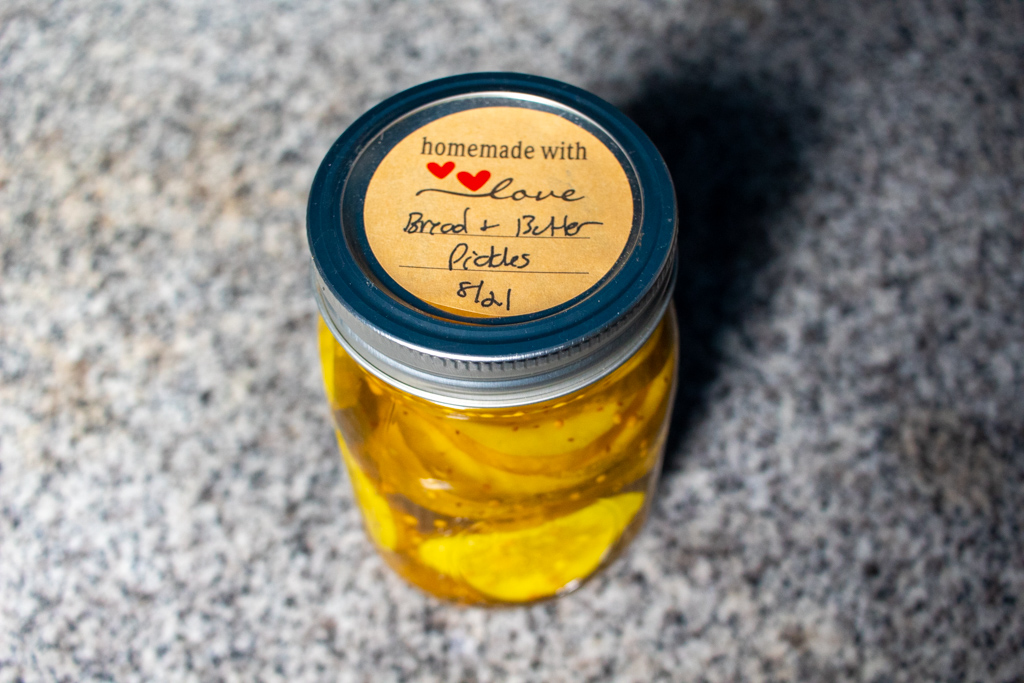
These are cut fairly thick, and their recipe uses half the sugar of many of the bread and butter pickles recipes I’ve seen, which may go a long way toward explaining why I like them better than most. There’s plenty of flavor here though even without all that sugar–the pungent and butter flavors of mustard and celery seeds along with a tingling hit of spicy ginger. I tried them–sparingly, hesitantly–on some plain whole wheat bread with a generous swipe of butter.

It was fine? I think I prefer the pickles by themselves though, fished furtively from the jar between meals, a healthier snack perhaps than a handful of chips.
And what of the peanut butter and pickle sandwich also mentioned in those same articles that put the idea of this post in my head?



I cannot bring myself to recommend it. Perhaps the main weakness of this particular example was the strength of the pickles, that they were less sweet than the typical bread and butter variety. Something more overtly jam-like perhaps, to help it lean in closer to PB&J territory. Or maybe a sweeter peanut butter than the natural variety I chose for this sandwich and a more pungent pickle, to provide some contrast in that direction. This was not it though.
An Historical Reenactment
Returning to those late 19th and early 20th Century cookbooks and their frequent instructions to set bread and butter on the table alongside pickles. To what end? What would that bread have looked like, and those pickles? Would the two have inevitably come together as a sandwich? It seems likely. Should I not then try that sandwich? And if I were to try it, should I not use that so very Danish recipe for bread and butter pickles provided by Mrs. Mae Hattie Andreason for the church cookbook?

I looked through the Breads chapter in Cook Book: Compiled by the Ladies Aid Society of the Danish Lutheran Church of Rosenborg, Nebraska and perhaps unsurprisingly, the only bread recipe I found that was not some kind of sweet roll was a recipe for a dense rye bread, something that would not be out of place back home in Denmark.

It’s not much of a recipe, and the proportions are for more rye bread than my family is likely to eat in a week, so I attempted to adapt it for a single ~800 gram loaf in a standard 9×5 loaf pan. I went with a far higher level of hydration than the original recipe called for because my first attempt resulted in an unworkable brick instead of dough.
Rye Bread (Danish Lutheran Ladies of Rosenborg Nebraska, circa 1920)
Ingredients
- 267 grams dark rye flour divided
- 133 grams all-purpose flour divided
- 220 ml water divided
- 2 tsp active dry yeast
- 80 grams buttermilk
- 1 tsp kosher salt
- 2 tsp sugar
Instructions
- Bloom yeast in 100ml of room-temperature water
- Mix 67 grams of dark rye flour and 33 grams of all-purpose flour into the yeast-water mixture until combined. Cover and let sit out overnight
- In bowl of stand mixer, combine pre-ferment with the remaining flours, salt, sugar, water, and buttermilk. Using dough hook, mix for 10 minutes, scraping down sides occasionally.
- Grease and flour a loaf pan. Scrape dough into pan and smooth surface. Cover with oiled plastic wrap and allow to rise until the dough surface is even with the top of the loaf pan.
- (Optional) gently spray with water and sprinkle surface of dough lightly with oats
- Bake at 325 for 1 hour. Cool completely in the pan before removing and slicing.
Notes
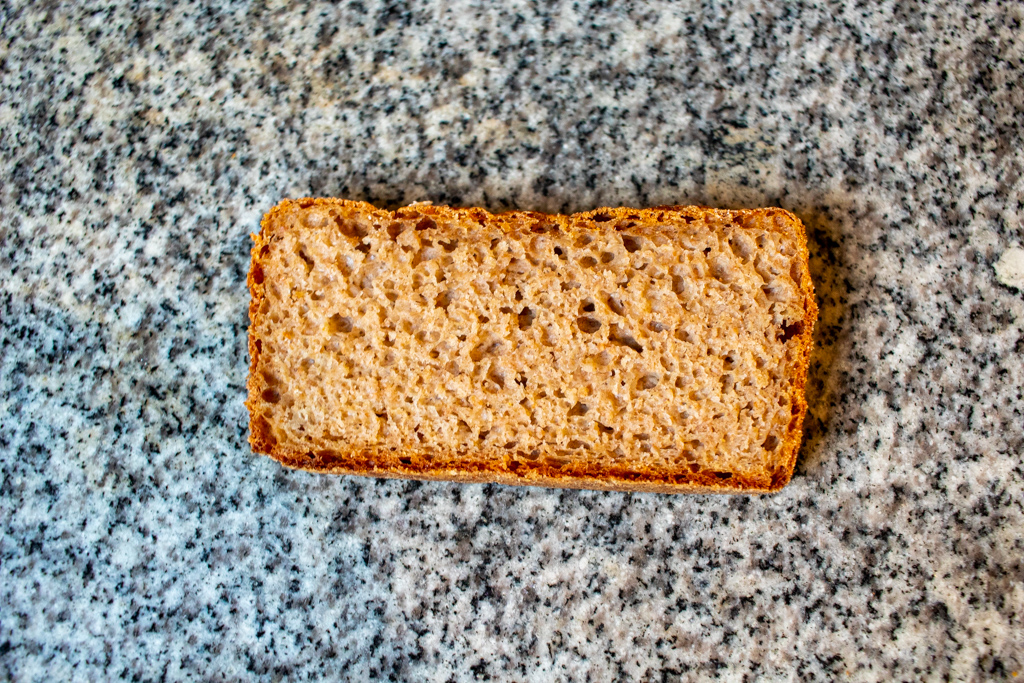
The loaf wasn’t the prettiest but the taste was good, less dense than the Danish Rugbrød I’ve had but welcome on the table toasted or not, simply slathered with some good butter.
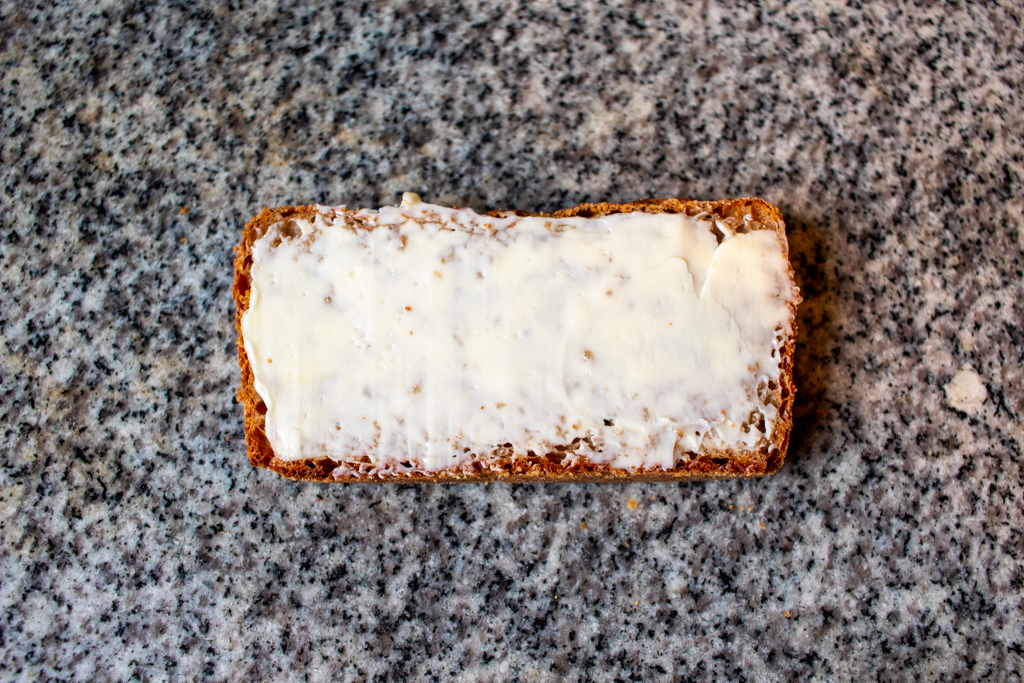
So how was it with the pickle?
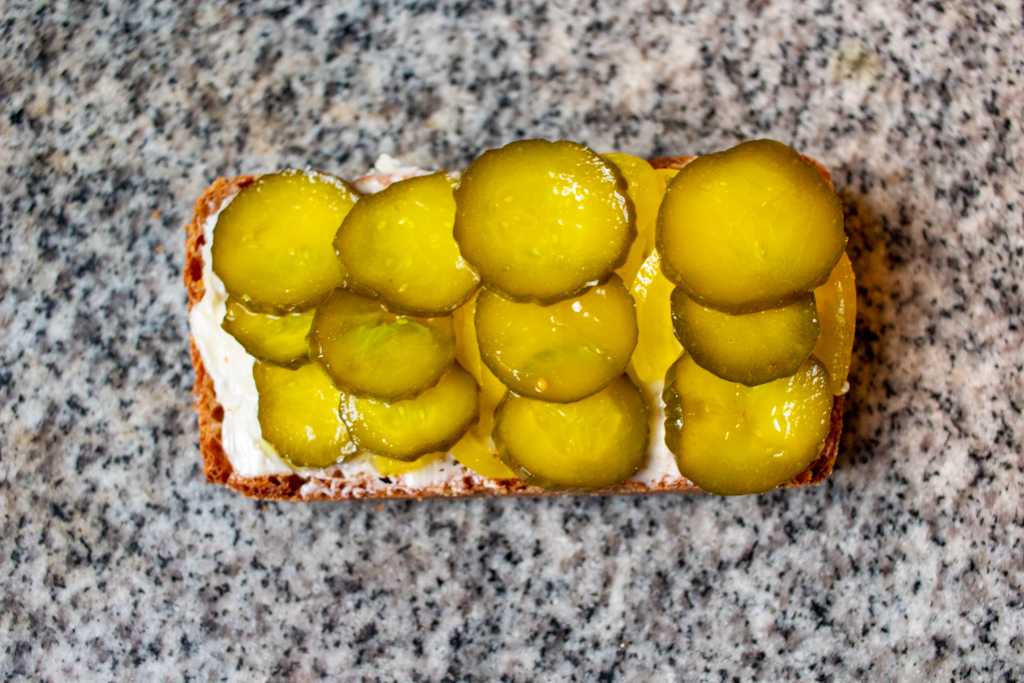
Angels did not descend from the heavens and alight upon my table to sing the sandwich’s praises. But this rye-heavy bread, this thick swipe of butter, this sweet mix of pickled cucumber and onion, it all seems quite familiar. Put a slice of corned beef on there or some pate and you’d have a smørrebrød.
And what does the Danish word smørrebrød mean? Bread and butter, basically. Eat up, Internet! And tell me how wrong I am.
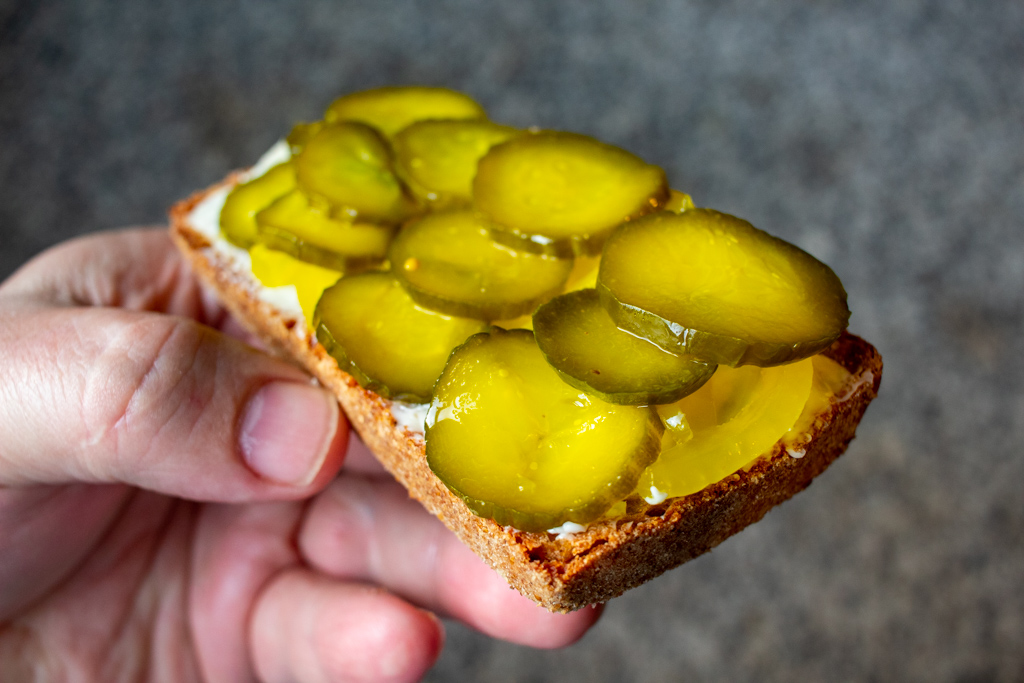

I like sandwiches.
I like a lot of other things too but sandwiches are pretty great


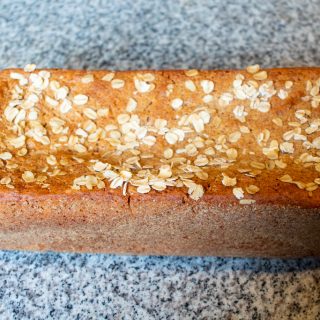

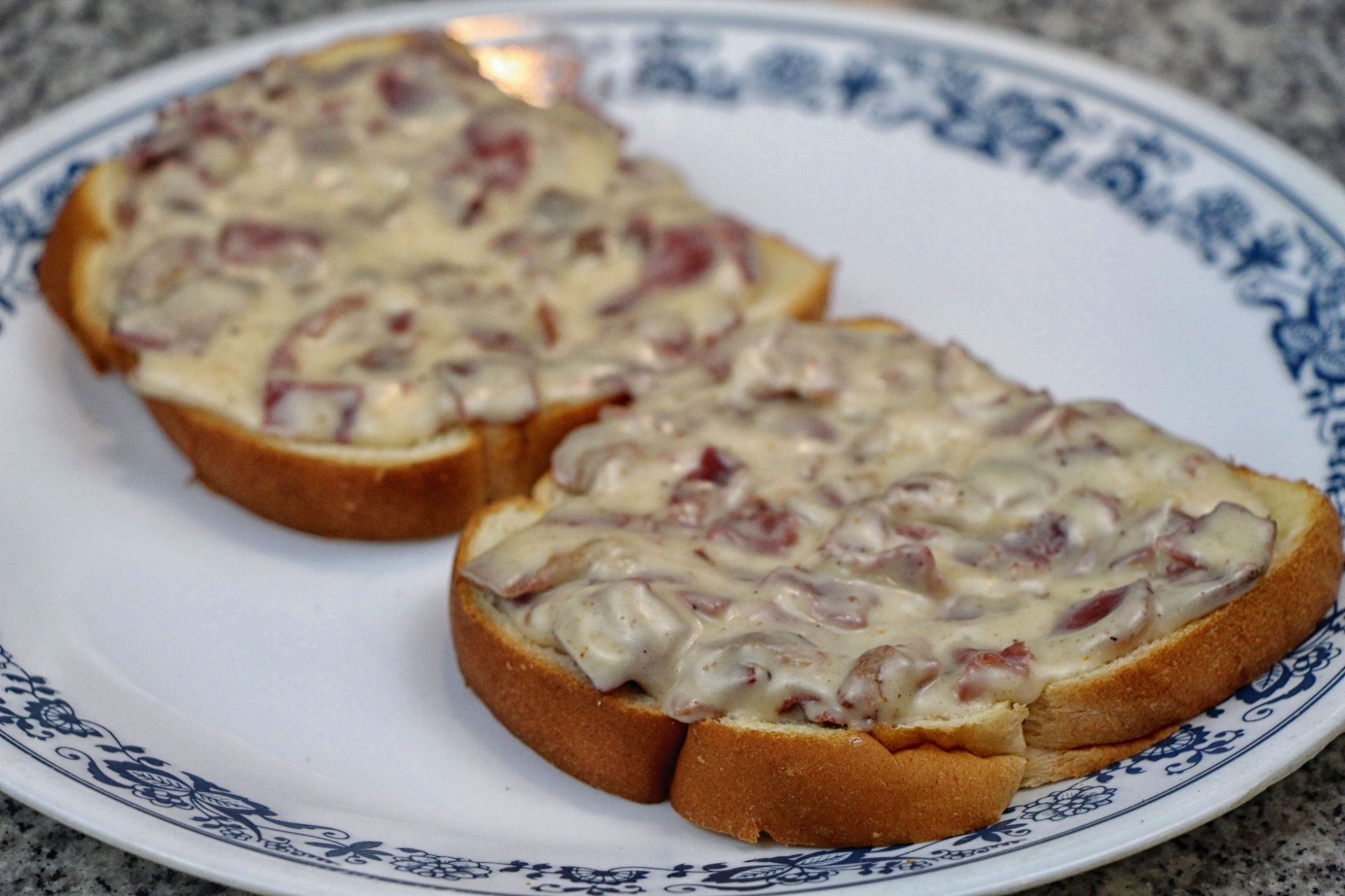







This is a very cool article. My mom always made pickles every summer, and I now live less than an hour from Genoa. I really look forward to your posts!
Thanks Bob! Have you tried making your mom’s pickle recipe? My grandfather made the best pickles and I regret not getting the recipe from him.
Never had the nerve to try the pickles, but I feel the need to tell you that I had a cousin growing up in another small Nebraska town who brought beaver and noodles for school lunch.
I heartily dislike “bread & butter” pickles, but was an avid eater of peanut butter & dill pickle sandwiches in grade school. My sister started eating them and I soon followed. Great way to alienate your classmates during lunch hour in 5th grade. Thanks for another great article!
Bread and butter pickles aren’t exactly my bread and butter either! I’m glad you found the site, thanks for the comment! 🙂